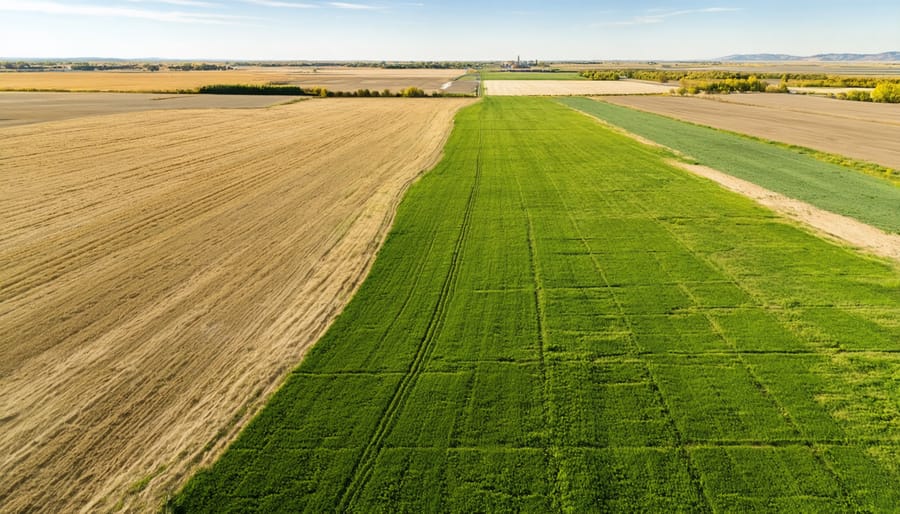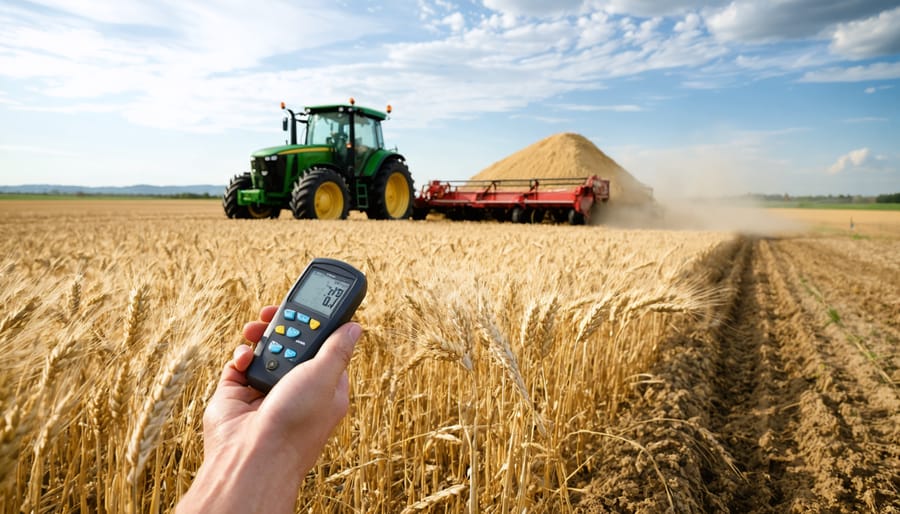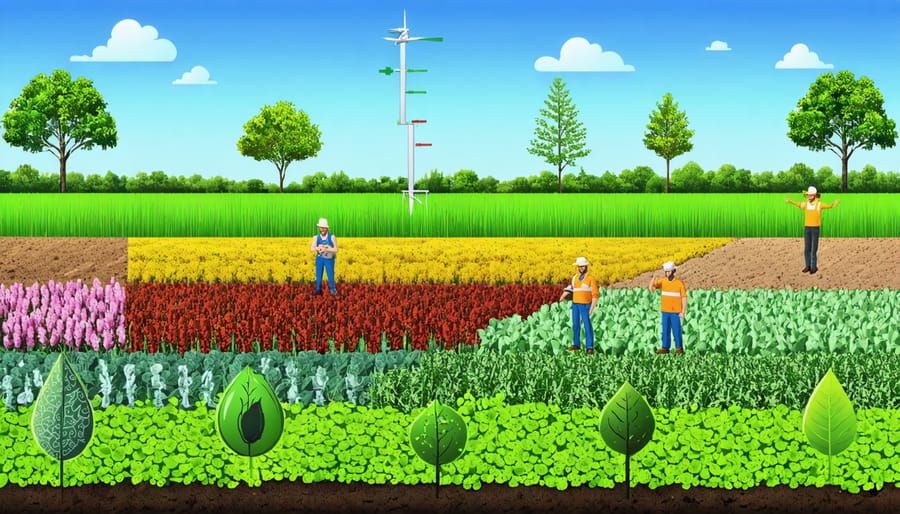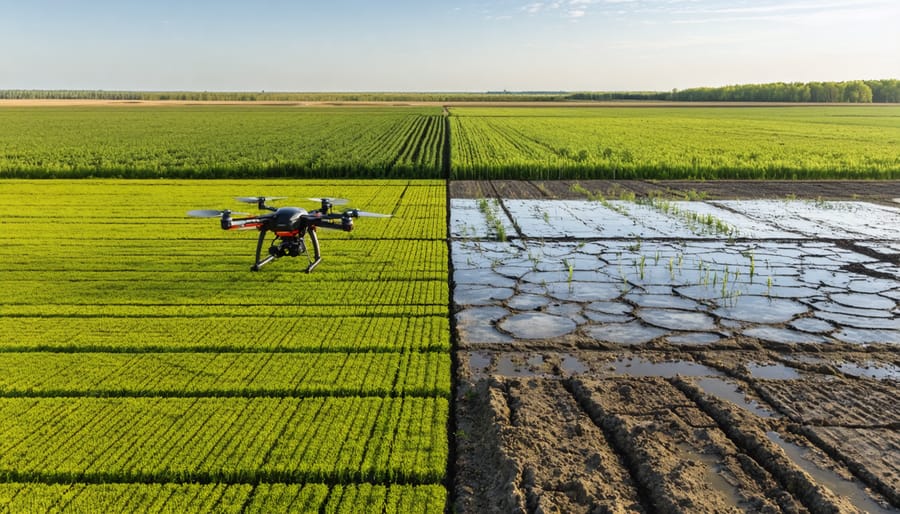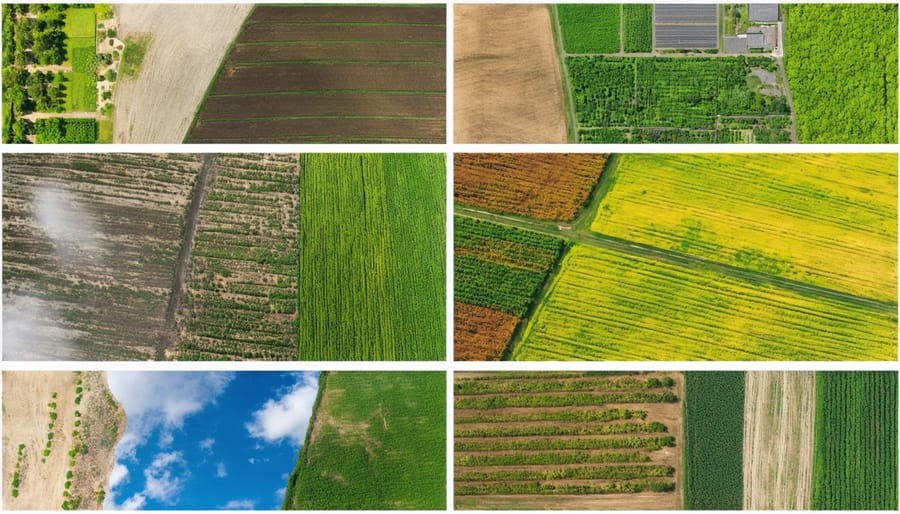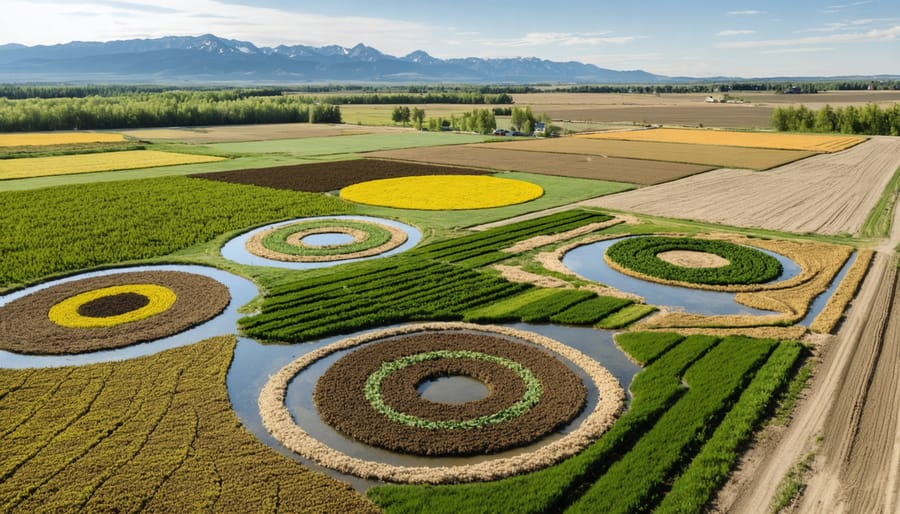Beneath every thriving Alberta farm lies an invisible workforce of billions – the microscopic organisms that form soil microbial communities. These dynamic networks of bacteria, fungi, and other microorganisms transform ordinary dirt into living, productive soil that powers our agricultural success. Recent research from the University of Alberta shows that just one teaspoon of healthy soil contains more microbes than there are people on Earth, working tirelessly to break down organic matter, cycle nutrients, and create the foundation for robust crop yields.
For Alberta farmers facing increasingly unpredictable growing conditions, understanding and nurturing these microbial communities isn’t just science – it’s a practical strategy for building resilient, productive farmland. From the rich black soils of central Alberta to the challenging brown soils of the southeast, these microscopic allies help crops access nutrients, fight diseases, and withstand stress. They’re the key to reducing input costs while improving soil structure, water retention, and long-term sustainability.
By working with nature’s smallest farmers, we’re discovering how to build stronger, more productive agricultural systems that can weather whatever challenges tomorrow brings. The health of our soil microbes directly impacts our farms’ bottom lines, our crop quality, and our ability to sustain production for generations to come.
Understanding Your Soil’s Living Network
Key Players in Your Soil Ecosystem
Alberta’s soils are teeming with beneficial microorganisms that work together to create a thriving ecosystem. Bacteria are the most abundant, with billions present in just a gram of healthy soil. These microscopic powerhouses break down organic matter, fix nitrogen from the air, and make nutrients available to plants.
Fungi play an equally crucial role, particularly mycorrhizal fungi that form partnerships with plant roots. These fungi extend their thread-like hyphae through the soil, effectively increasing the plant’s root system by up to 1,000 times. In Alberta’s prairie soils, these fungi are especially important for helping crops access phosphorus and water during dry periods.
Protozoa and nematodes act as the soil’s natural regulators, feeding on bacteria and fungi while releasing nutrients in plant-available forms. Think of them as your soil’s recycling crew, keeping nutrient cycles moving and populations balanced.
Actinobacteria, often overlooked but vital players, produce antibiotics that help protect plants from pathogens. They’re particularly active in our province’s neutral to slightly alkaline soils, contributing to that characteristic “earthy” smell after rain.
Even earthworms, while not microscopic, work alongside these microorganisms by creating channels for air and water movement, mixing organic matter throughout the soil profile, and providing habitat for beneficial microbes in their castings. A healthy Alberta soil can support up to 1 million earthworms per acre, each contributing to your soil’s productivity.

The Vital Services Your Soil Microbes Provide
Those tiny microorganisms in your soil are the unsung heroes of your farm, working tirelessly to maintain a healthy and productive agricultural system. At the heart of their work is nutrient cycling, where bacteria and fungi break down organic matter into forms that your crops can readily use. Here in Alberta, these microbes are particularly crucial during our short growing season, helping to maximize nutrient availability when crops need it most.
Beyond nutrition, your soil microbes form a natural defense system against plant diseases. Beneficial organisms compete with pathogens for resources and space, while some even produce compounds that directly suppress harmful organisms. This biological protection can significantly reduce your need for chemical interventions and associated costs.
These microscopic workers are also master architects of soil structure. Through their activities, they produce sticky substances that bind soil particles together, creating stable aggregates. This improved structure increases water retention, reduces erosion risk, and provides better growing conditions for root development. Many Alberta farmers have noticed that fields with healthy microbial populations show better resilience during both dry spells and heavy rains.
Remember, every time you make management decisions that support these beneficial organisms, you’re investing in your soil’s long-term productivity and your farm’s success.
Real Alberta Success Stories

From Depleted to Thriving: The Johnson Farm Story
Located just outside of Red Deer, Alberta, the Johnson family farm stood as a stark reminder of decades of intensive farming practices. By 2015, their once-productive soil had become depleted, with crop yields declining steadily each season. Third-generation farmer Mark Johnson knew something had to change.
“Our soil tests showed extremely low organic matter and virtually no biological activity,” recalls Johnson. “We were essentially farming in dirt, not living soil.”
Determined to turn things around, Johnson partnered with soil microbiologist Dr. Sarah Chen from the University of Alberta to begin restoring soil health through targeted microbial management. They implemented a comprehensive strategy that included reducing tillage, introducing cover crops, and applying specially formulated biological amendments.
Within three years, the results were remarkable. Soil organic matter increased from 2% to 4.5%, earthworm populations flourished, and beneficial fungi networks became established. Most importantly, crop yields improved by 30% while chemical input costs decreased by 40%.
Today, the Johnson farm serves as a demonstration site for other Alberta farmers interested in soil microbial restoration. “The transformation wasn’t just about the numbers,” Johnson explains. “You can literally feel the difference in the soil structure. It’s alive again, and that’s what sustainable farming is all about.”
Building Biodiversity in Central Alberta
In Central Alberta, farmers are joining forces to create a network of biodiversity-rich soil systems that benefit the entire agricultural community. The “Healthy Soils Network,” launched in 2019, connects over 40 farms across Red Deer, Lacombe, and Ponoka counties, showcasing the power of collective action in soil improvement.
Local farmer Sarah Thompson, who coordinates the network, explains, “We’re seeing remarkable changes in our soil structure and crop health since implementing diverse cover crop rotations and reduced tillage practices. What’s even better is that we’re learning from each other’s experiences.”
The network organizes regular soil testing events where members compare microbial activity across different management practices. Participating farms have reported a 30% increase in beneficial fungi populations and improved water retention capacity after just two growing seasons.
Key community initiatives include a seed-sharing program for cover crops, monthly field days where farmers showcase successful practices, and partnerships with local agricultural extension services. The group also maintains a digital database of soil health indicators, helping members track progress and adjust their management strategies accordingly.
“What makes this approach special is that we’re not just improving our own farms,” notes Thompson. “We’re creating corridors of healthy soil that support native pollinators and beneficial insects across the region, making our whole agricultural ecosystem more resilient.”
Practical Steps to Enhance Your Soil Microbiome
Smart Crop Rotation Strategies
Smart crop rotation is a cornerstone of maintaining healthy soil microbial communities in Alberta’s diverse agricultural landscape. By alternating between different crop families, you create an environment where various beneficial microorganisms can thrive throughout the growing seasons.
Start by planning a three to four-year rotation that includes cereals, legumes, and oilseeds. For example, a successful Alberta rotation might include wheat, followed by field peas, canola, and then barley. This sequence helps break pest cycles while supporting different microbial groups. Legumes, particularly, play a crucial role by hosting nitrogen-fixing bacteria that benefit subsequent crops.
Consider incorporating cover crops during shoulder seasons. Quick-growing options like fall rye or winter wheat protect soil microbes during Alberta’s harsh winters while adding organic matter. Local farmers have reported success with cocktail cover crops – mixtures of different species that support diverse microbial populations.
Timing is essential – plan transitions between crops to minimize periods of bare soil. This maintains microbial activity and prevents population crashes. Many Alberta farmers have found success by seeding their cover crops before harvesting the main crop, ensuring continuous root presence in the soil.
Remember to monitor soil moisture levels when planning rotations, as adequate moisture is crucial for microbial activity. In drier regions of the province, consider including drought-tolerant crops in your rotation to maintain soil biology during challenging seasons.

Organic Matter Management
Maintaining healthy organic matter levels is crucial for thriving soil microbial communities in Alberta’s diverse agricultural landscape. Regular additions of crop residue, cover crops, and composted materials create the foundation for robust microbial activity. Many successful Alberta farmers practice minimal tillage and incorporate diverse crop rotations to preserve existing organic matter while building new reserves.
For optimal results, aim to maintain organic matter levels between 3-5% in cultivated fields. This target supports both soil structure and microbial diversity. Local studies show that fields maintaining these levels typically demonstrate better water retention and nutrient cycling, particularly important during our prairie province’s dry spells.
Consider implementing these practical strategies:
– Leave crop residue on fields after harvest
– Plant cover crops during shoulder seasons
– Apply composted manure when available
– Rotate between deep and shallow-rooted crops
– Minimize soil disturbance during field operations
Many Alberta farmers have found success with winter cover crops like fall rye, which protect soil through harsh winters while contributing valuable organic matter. The key is consistency – small, regular additions of organic materials often prove more beneficial than occasional large applications.
Remember that building organic matter is a long-term investment. While results may take years to become visible, the benefits to soil health and crop productivity make it worthwhile for sustainable farming operations.
Minimizing Soil Disturbance
Minimizing soil disturbance is crucial for maintaining healthy microbial communities in Alberta’s agricultural lands. When we reduce tillage practices, we protect the intricate network of fungal hyphae and bacterial colonies that have established themselves in the soil.
Here in Alberta, many farmers have successfully adopted reduced tillage methods that work well with our climate. Direct seeding, for instance, allows crops to be planted with minimal disruption to the soil structure. This practice has shown particular success in areas around Lethbridge and Red Deer, where farmers report improved soil moisture retention and reduced erosion.
Consider implementing these practical techniques to protect your soil:
– Use precision farming equipment designed for minimal soil impact
– Practice controlled traffic farming to limit compaction
– Maintain crop residue on the surface rather than incorporating it
– Consider strip-tillage when full no-till isn’t feasible
– Plant cover crops to protect soil during vulnerable periods
Remember that transition to reduced tillage systems should be gradual. Start with a small test plot to gain confidence in the new approach. Many Alberta farmers have found that winter wheat and canola respond particularly well to reduced tillage practices, especially when combined with proper residue management.
The soil structure you preserve today will benefit your farm for generations to come, supporting not just the microbial communities but the entire agricultural ecosystem.
Monitoring and Maintaining Soil Health
Regular assessment of your soil’s microbial activity is crucial for maintaining healthy and productive farmland. As Alberta farmers, monitoring soil health through simple, practical methods can provide valuable insights into your land’s biological activity.
Start with visual soil assessments by examining soil structure, earthworm counts, and root development. A healthy soil should have a crumbly texture and visible organic matter. Consider using the soil tea bag test – burying tea bags at various locations and checking decomposition rates after 90 days can indicate microbial activity levels.
Laboratory testing provides more detailed information about your soil’s microbial communities. Local agricultural extension offices offer comprehensive soil biology tests that measure microbial biomass, diversity, and enzyme activity. Aim to conduct these tests annually, preferably in spring before planting.
Keep detailed records of your observations and test results. Many successful Alberta farmers maintain soil health journals, tracking changes across seasons and years. This information helps identify trends and adjust management practices accordingly.
Remember that healthy soils typically show increasing organic matter levels, improved water retention, and reduced need for synthetic inputs over time. Regular monitoring helps ensure your soil management practices are supporting, not hindering, your vital microbial communities.
The journey to understanding and nurturing soil microbial communities is an ongoing process that offers tremendous potential for Alberta’s agricultural future. As we’ve explored throughout this article, these microscopic organisms play a vital role in maintaining healthy, productive soils that support sustainable farming practices across our province.
By implementing the management strategies we’ve discussed, such as reducing tillage, maintaining soil cover, and practicing crop rotation, you’re not just improving your soil – you’re investing in the long-term success of your farm. Remember that healthy microbial communities contribute to better nutrient cycling, improved water retention, and enhanced crop resilience – benefits that directly impact your bottom line.
Many Alberta farmers have already witnessed positive results from adopting microbial-friendly practices. From reduced input costs to improved yields, the evidence supporting these approaches continues to grow. The success stories we’ve shared from local farms demonstrate that these methods work in our unique climate and soil conditions.
Moving forward, consider starting small with these practices on a portion of your land. Monitor the changes, connect with other farmers who are on similar journeys, and reach out to local agricultural extension services for support. The agricultural community in Alberta has always been strong, and sharing our experiences helps everyone succeed.
As climate patterns become more unpredictable, maintaining robust soil microbial communities becomes increasingly important for farm resilience. The good news is that every step you take toward supporting these beneficial organisms contributes to building stronger, more sustainable agricultural systems.
Remember, healthy soil is living soil. By working with nature’s own processes and nurturing these invisible allies beneath our feet, we’re not just farming for today – we’re cultivating a legacy for future generations of Alberta farmers. Take that first step today, whether it’s reducing tillage on one field or planning next season’s cover crop. Your soil microbes will thank you, and so will your future harvests.


